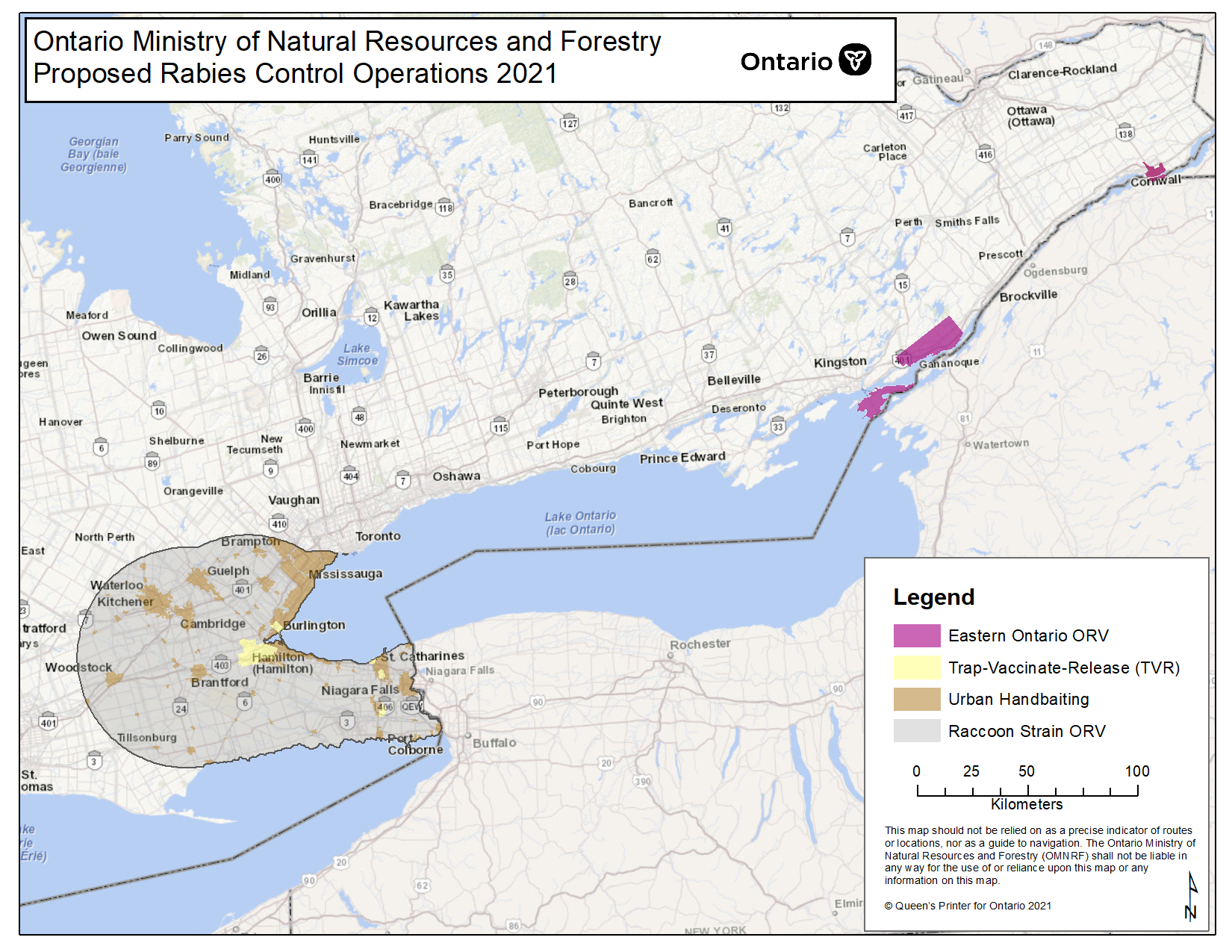
In 2021, the Ministry of Natural Resources and Forestry (MNRF) will once again be conducting Oral Rabies Vaccine (ORV) bait distribution and trap-vaccinate-release (TVR) programs in Ontario. Baiting and TVR operations will begin June 28 and continue until the end of October.
The ministry’s rabies control operations are essential to public health and to the health of wildlife. With the current COVID-19 outbreak, additional health and safety measures have been put into place using the best available information from Public Health Ontario to deliver this program safely and minimize risks to staff, the public, and wildlife. The ministry will continue to re-evaluate as the response to the COVID-19 outbreak continues.
Please find attached:
1) Map of planned baiting area for 2021
2) Rabies Vaccine Bait Information Sheet
Per the attached map, rabies vaccine bait distribution will be conducted in rural areas with MNRF aircraft and by hand in urban areas by MNRF wildlife technicians. These are the details of bait distribution work in 2021 (dates are subject to change depending on weather conditions):
- Grey shaded areas will be completed with a combination of Twin Otter airplane and Eurocopter EC130 helicopter. Twin Otter flights will occur from August 16 through to August 22, with Eurocopter EC130 flights occurring August 9 to 13.
- Urban hand baiting, including the use of temporary bait stations, will occur in the brown shaded areas starting June 28 and continue through to the end of October.
- Live trapping and vaccinating wildlife (trap-vaccinate-release) will occur in the areas surrounding Hamilton shaded in yellow starting June 28 and will continue through to the end of October.
- Preventative baiting of the purple shaded areas in eastern Ontario will take place in early August and will take one day to complete.
In addition to the activities mentioned above, MNRF may conduct localized rapid response baiting and trap-vaccinate-release measures, which would take place in the event of a raccoon or fox strain rabies case outside of the planned baiting area.
The ministry is committed to the research, surveillance, control and elimination of the outbreak of rabies in southwestern Ontario to prevent the disease from spreading. Since the start of the rabies outbreak in 2015, the first of its kind in over a decade, MNRF has taken quick action to protect communities, distributing over six million vaccine baits by air and ground. Rabies cases have decreased by about 50% each year since 2016, and there was a 70 per cent decrease in the number of rabies cases in 2020 from 2019.
In keeping with current World Health Organization guidelines, the 2021 rabies control zone has been reduced as some areas have had no reported cases in over two years. The control zone encompasses an area within 50 km of positive cases that are less than years old (positive cases since July 1, 2019).
Any warm-blooded mammal can contract rabies. If a human contracts rabies and does not receive treatment, the disease is fatal.
The khaki-green coloured bait being distributed by hand and by aircraft is made of wax-fat with an attractant flavour (vanilla-sugar). A label with a toll-free telephone number (1-888-574-6656) and the message “Do not eat” is located on the exterior of the bait, and a plastic package containing the liquid rabies vaccine is embedded in the centre. If found, the bait should not be touched, but left for raccoons, skunks and foxes to consume. (See attached bait identification hand out for detailed description.)
Ontario’s rabies vaccine baits have been tested to ensure they are safe for wildlife, people and pets. However, eating a vaccine bait does not replace the regular rabies vaccination provided by a veterinarian for your pet. If your pet has eaten a bait and you are concerned, contact your vet as a precaution.
Ontario’s rabies control program is a joint effort that receives important input and contributions from a variety of partners across the province. Partnerships with provincial ministries, federal agencies, regional health units, municipalities, wildlife rehabilitators, licensed trappers, wildlife control agents and Indigenous communities are all key to the continued success of Ontario’s rabies control program.
For further information about rabies in Ontario, please visit Ontario.ca/rabies or contact MNRF’s rabies information line at 1-888-574-6656.
Larissa Nituch
Rabies Science Operations Supervisor
705-313-2043 (cell)
Larissa.Nituch@ontario.ca

Attachments
Contact Us





